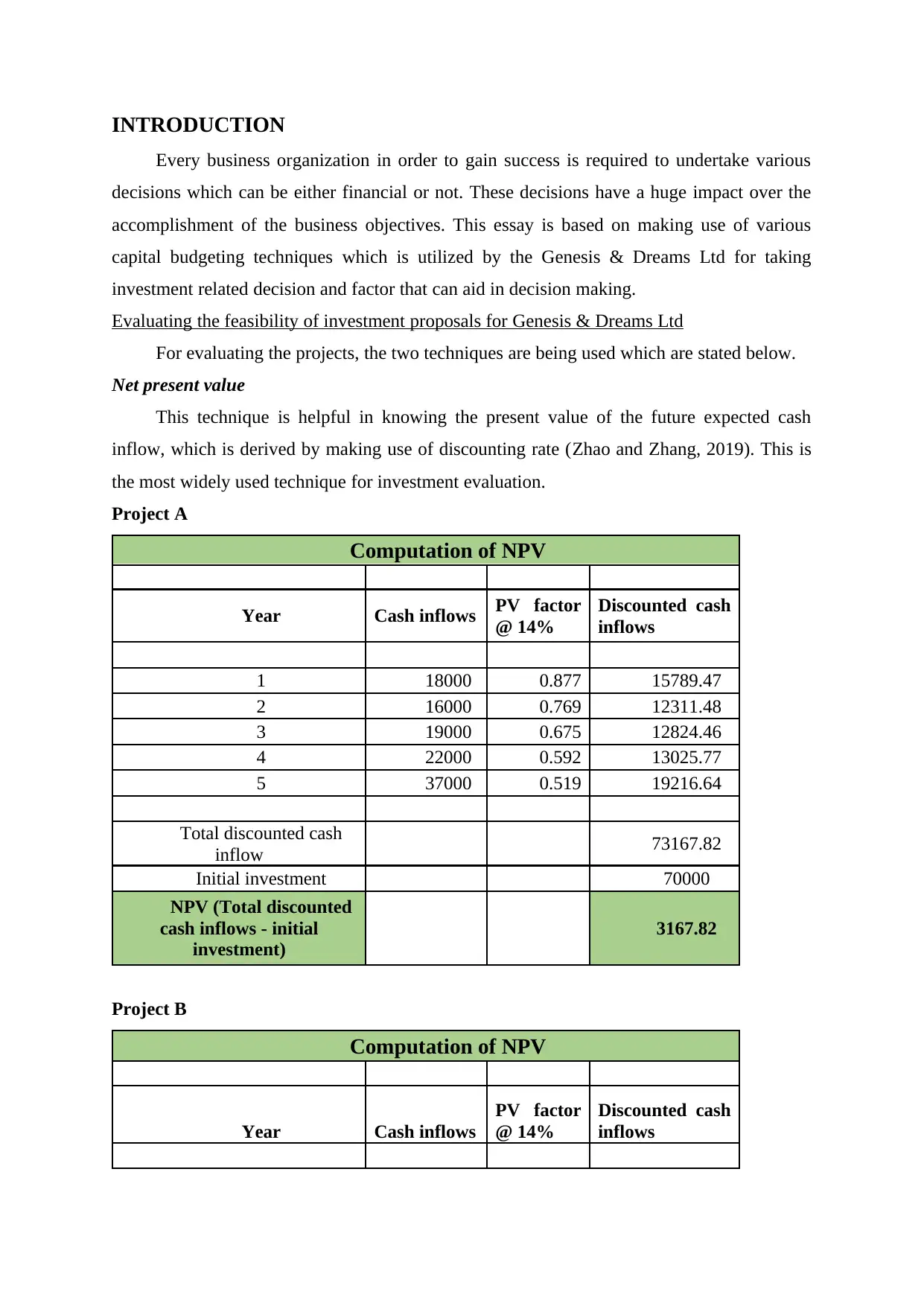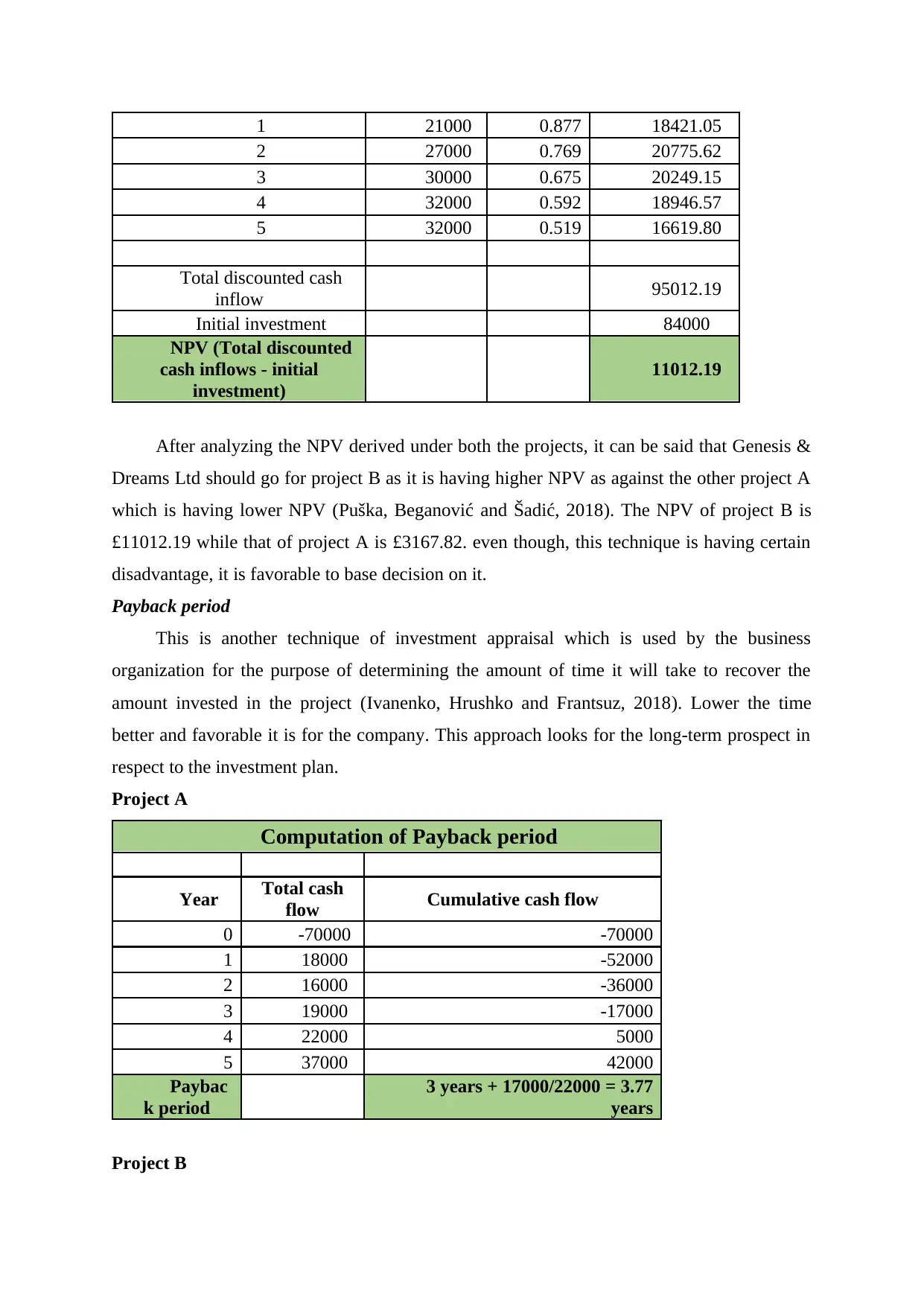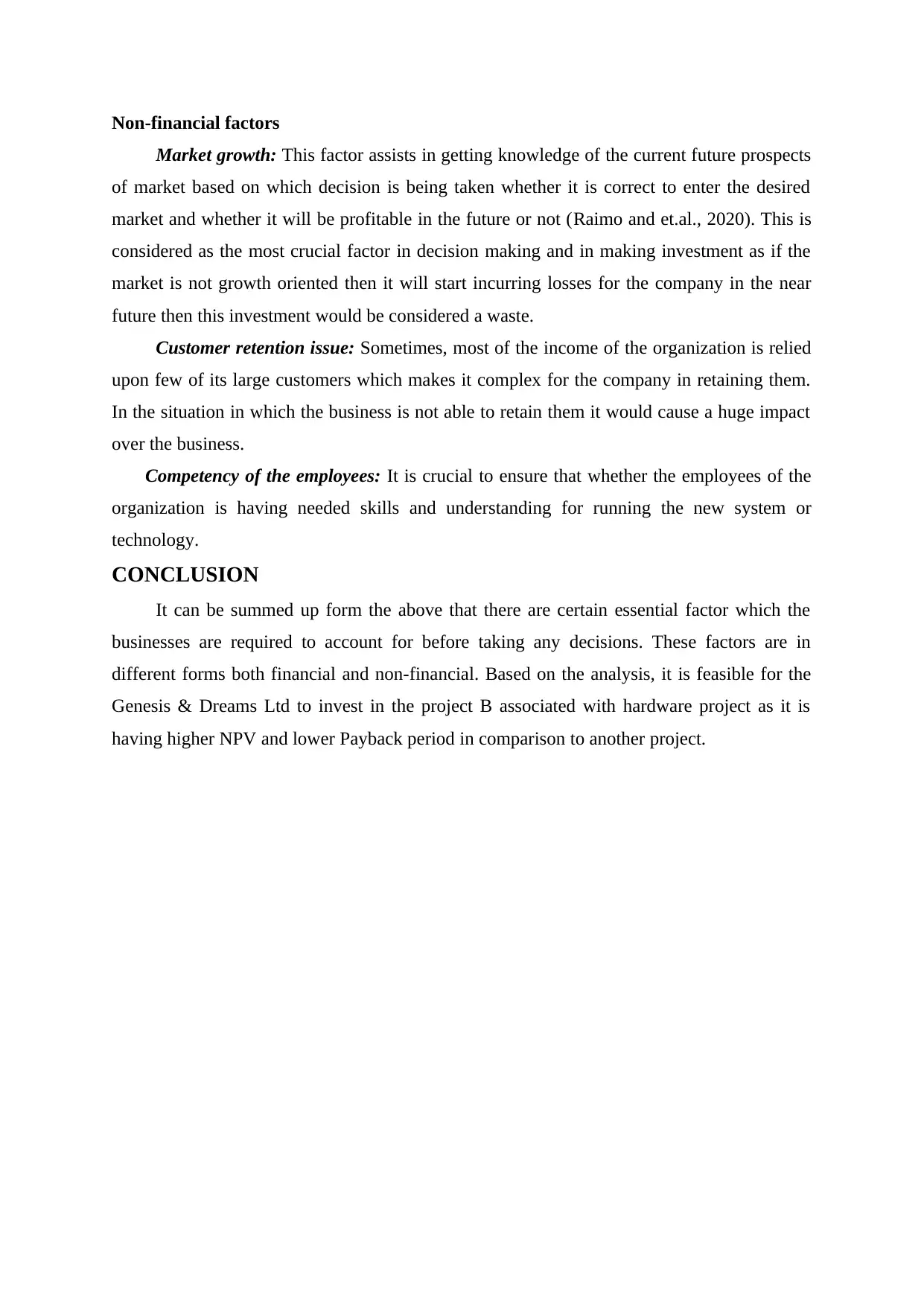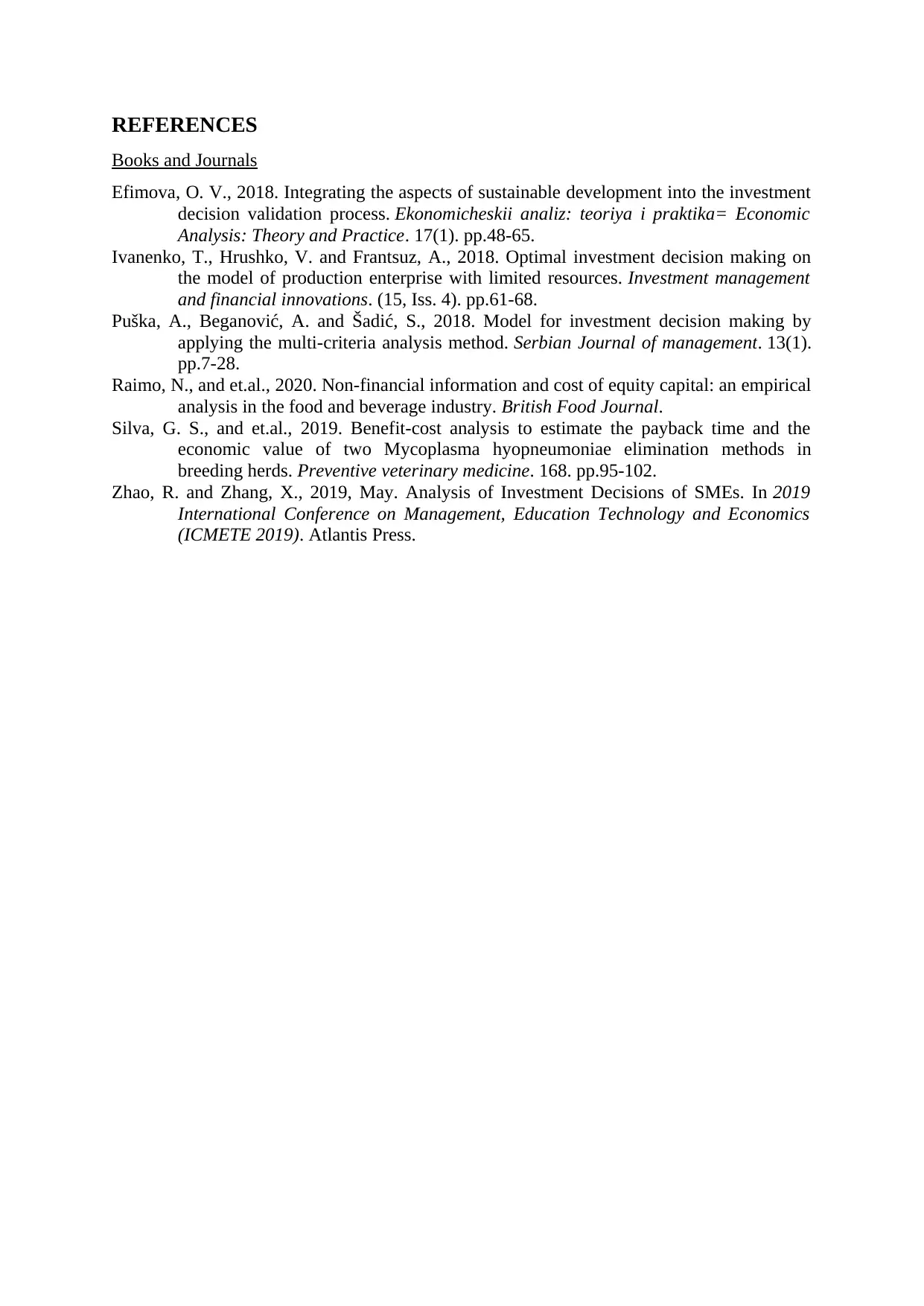Investment Appraisal and Financial Decision Making for G&D Ltd
VerifiedAdded on 2023/01/06
|7
|1366
|56
Report
AI Summary
This report provides a comprehensive analysis of financial decision-making processes, specifically focusing on investment appraisal techniques used by Genesis & Dreams Ltd. It evaluates two projects using Net Present Value (NPV) and Payback Period methods, concluding that Project B is more favorable due to its higher NPV and shorter payback period. The report also delves into critical financial and non-financial factors influencing investment decisions, such as cost, risk, liquidity, profitability, market growth, customer retention, and employee competency. By considering these factors, businesses can make informed choices that align with their objectives. The analysis highlights the importance of a holistic approach to financial decision-making, ensuring that both quantitative and qualitative aspects are considered for successful investment outcomes.

Business Decision Making
Paraphrase This Document
Need a fresh take? Get an instant paraphrase of this document with our AI Paraphraser

TABLE OF CONTENTS
INTRODUCTION......................................................................................................................3
Evaluating the feasibility of investment proposals for Genesis & Dreams Ltd...............3
Factor to be considered at the time of making financial decisions...................................5
CONCLUSION..........................................................................................................................6
REFERENCES...........................................................................................................................7
INTRODUCTION......................................................................................................................3
Evaluating the feasibility of investment proposals for Genesis & Dreams Ltd...............3
Factor to be considered at the time of making financial decisions...................................5
CONCLUSION..........................................................................................................................6
REFERENCES...........................................................................................................................7

INTRODUCTION
Every business organization in order to gain success is required to undertake various
decisions which can be either financial or not. These decisions have a huge impact over the
accomplishment of the business objectives. This essay is based on making use of various
capital budgeting techniques which is utilized by the Genesis & Dreams Ltd for taking
investment related decision and factor that can aid in decision making.
Evaluating the feasibility of investment proposals for Genesis & Dreams Ltd
For evaluating the projects, the two techniques are being used which are stated below.
Net present value
This technique is helpful in knowing the present value of the future expected cash
inflow, which is derived by making use of discounting rate (Zhao and Zhang, 2019). This is
the most widely used technique for investment evaluation.
Project A
Computation of NPV
Year Cash inflows PV factor
@ 14%
Discounted cash
inflows
1 18000 0.877 15789.47
2 16000 0.769 12311.48
3 19000 0.675 12824.46
4 22000 0.592 13025.77
5 37000 0.519 19216.64
Total discounted cash
inflow 73167.82
Initial investment 70000
NPV (Total discounted
cash inflows - initial
investment)
3167.82
Project B
Computation of NPV
Year Cash inflows
PV factor
@ 14%
Discounted cash
inflows
Every business organization in order to gain success is required to undertake various
decisions which can be either financial or not. These decisions have a huge impact over the
accomplishment of the business objectives. This essay is based on making use of various
capital budgeting techniques which is utilized by the Genesis & Dreams Ltd for taking
investment related decision and factor that can aid in decision making.
Evaluating the feasibility of investment proposals for Genesis & Dreams Ltd
For evaluating the projects, the two techniques are being used which are stated below.
Net present value
This technique is helpful in knowing the present value of the future expected cash
inflow, which is derived by making use of discounting rate (Zhao and Zhang, 2019). This is
the most widely used technique for investment evaluation.
Project A
Computation of NPV
Year Cash inflows PV factor
@ 14%
Discounted cash
inflows
1 18000 0.877 15789.47
2 16000 0.769 12311.48
3 19000 0.675 12824.46
4 22000 0.592 13025.77
5 37000 0.519 19216.64
Total discounted cash
inflow 73167.82
Initial investment 70000
NPV (Total discounted
cash inflows - initial
investment)
3167.82
Project B
Computation of NPV
Year Cash inflows
PV factor
@ 14%
Discounted cash
inflows
⊘ This is a preview!⊘
Do you want full access?
Subscribe today to unlock all pages.

Trusted by 1+ million students worldwide

1 21000 0.877 18421.05
2 27000 0.769 20775.62
3 30000 0.675 20249.15
4 32000 0.592 18946.57
5 32000 0.519 16619.80
Total discounted cash
inflow 95012.19
Initial investment 84000
NPV (Total discounted
cash inflows - initial
investment)
11012.19
After analyzing the NPV derived under both the projects, it can be said that Genesis &
Dreams Ltd should go for project B as it is having higher NPV as against the other project A
which is having lower NPV (Puška, Beganović and Šadić, 2018). The NPV of project B is
£11012.19 while that of project A is £3167.82. even though, this technique is having certain
disadvantage, it is favorable to base decision on it.
Payback period
This is another technique of investment appraisal which is used by the business
organization for the purpose of determining the amount of time it will take to recover the
amount invested in the project (Ivanenko, Hrushko and Frantsuz, 2018). Lower the time
better and favorable it is for the company. This approach looks for the long-term prospect in
respect to the investment plan.
Project A
Computation of Payback period
Year Total cash
flow Cumulative cash flow
0 -70000 -70000
1 18000 -52000
2 16000 -36000
3 19000 -17000
4 22000 5000
5 37000 42000
Paybac
k period
3 years + 17000/22000 = 3.77
years
Project B
2 27000 0.769 20775.62
3 30000 0.675 20249.15
4 32000 0.592 18946.57
5 32000 0.519 16619.80
Total discounted cash
inflow 95012.19
Initial investment 84000
NPV (Total discounted
cash inflows - initial
investment)
11012.19
After analyzing the NPV derived under both the projects, it can be said that Genesis &
Dreams Ltd should go for project B as it is having higher NPV as against the other project A
which is having lower NPV (Puška, Beganović and Šadić, 2018). The NPV of project B is
£11012.19 while that of project A is £3167.82. even though, this technique is having certain
disadvantage, it is favorable to base decision on it.
Payback period
This is another technique of investment appraisal which is used by the business
organization for the purpose of determining the amount of time it will take to recover the
amount invested in the project (Ivanenko, Hrushko and Frantsuz, 2018). Lower the time
better and favorable it is for the company. This approach looks for the long-term prospect in
respect to the investment plan.
Project A
Computation of Payback period
Year Total cash
flow Cumulative cash flow
0 -70000 -70000
1 18000 -52000
2 16000 -36000
3 19000 -17000
4 22000 5000
5 37000 42000
Paybac
k period
3 years + 17000/22000 = 3.77
years
Project B
Paraphrase This Document
Need a fresh take? Get an instant paraphrase of this document with our AI Paraphraser

Computation of Payback period
Year Total cash
flow Cumulative cash flow
0 -84000 -84000
1 21000 -63000
2 27000 -36000
3 30000 -6000
4 32000 26000
5 32000 58000
Paybac
k period
3 years + 6000/32000 = 3.19
years
The payback period derived under project A is 3.77 years while in project B is 3.19
years, which indicates that it is favorable and feasible to make an investment in the project B
as lower the PBP better it is for the company (Silva and et.al., 2019). This indicates that
company will be able to generate the amount initially invested in the project in 3.19 years.
Factor to be considered at the time of making financial decisions
There are various factors to be accounted for before taking any decision. The decision
can be influenced by both financial and non-financial aspects. Following are the some of the
crucial factors that the business must considers.
Financial factors:
Cost and risk associated with it: the business requires to analyse the cost which
involved in providing fund to the investment along with analysing the risk in relation of each
source of fund. This is useful in comparing risk with the cost. Based on this, the decision can
eb taken which source of finance should be selected to meet with the requirement.
Liquidity position: Under this, the business will be evaluated in respect to the
availability of the liquid assets for meeting the uncertain future events (Efimova, 2018).
Having consistent cash inflow will help the organization in further borrowing of the funds.
This analysis will help in gaining insight about the financial position of the business in
running its business smoothly.
Profitability: The trend of the company in generating income will allow the
management in making meaningful decision on account of whether the company will be able
to repay its borrowed funds on time or not. If the profits of the company is not stable it would
mean that there is risk in borrowing additional funds as there is possibility that the company
might fail to repay back resulting occurrence of huge problem.
Year Total cash
flow Cumulative cash flow
0 -84000 -84000
1 21000 -63000
2 27000 -36000
3 30000 -6000
4 32000 26000
5 32000 58000
Paybac
k period
3 years + 6000/32000 = 3.19
years
The payback period derived under project A is 3.77 years while in project B is 3.19
years, which indicates that it is favorable and feasible to make an investment in the project B
as lower the PBP better it is for the company (Silva and et.al., 2019). This indicates that
company will be able to generate the amount initially invested in the project in 3.19 years.
Factor to be considered at the time of making financial decisions
There are various factors to be accounted for before taking any decision. The decision
can be influenced by both financial and non-financial aspects. Following are the some of the
crucial factors that the business must considers.
Financial factors:
Cost and risk associated with it: the business requires to analyse the cost which
involved in providing fund to the investment along with analysing the risk in relation of each
source of fund. This is useful in comparing risk with the cost. Based on this, the decision can
eb taken which source of finance should be selected to meet with the requirement.
Liquidity position: Under this, the business will be evaluated in respect to the
availability of the liquid assets for meeting the uncertain future events (Efimova, 2018).
Having consistent cash inflow will help the organization in further borrowing of the funds.
This analysis will help in gaining insight about the financial position of the business in
running its business smoothly.
Profitability: The trend of the company in generating income will allow the
management in making meaningful decision on account of whether the company will be able
to repay its borrowed funds on time or not. If the profits of the company is not stable it would
mean that there is risk in borrowing additional funds as there is possibility that the company
might fail to repay back resulting occurrence of huge problem.

Non-financial factors
Market growth: This factor assists in getting knowledge of the current future prospects
of market based on which decision is being taken whether it is correct to enter the desired
market and whether it will be profitable in the future or not (Raimo and et.al., 2020). This is
considered as the most crucial factor in decision making and in making investment as if the
market is not growth oriented then it will start incurring losses for the company in the near
future then this investment would be considered a waste.
Customer retention issue: Sometimes, most of the income of the organization is relied
upon few of its large customers which makes it complex for the company in retaining them.
In the situation in which the business is not able to retain them it would cause a huge impact
over the business.
Competency of the employees: It is crucial to ensure that whether the employees of the
organization is having needed skills and understanding for running the new system or
technology.
CONCLUSION
It can be summed up form the above that there are certain essential factor which the
businesses are required to account for before taking any decisions. These factors are in
different forms both financial and non-financial. Based on the analysis, it is feasible for the
Genesis & Dreams Ltd to invest in the project B associated with hardware project as it is
having higher NPV and lower Payback period in comparison to another project.
Market growth: This factor assists in getting knowledge of the current future prospects
of market based on which decision is being taken whether it is correct to enter the desired
market and whether it will be profitable in the future or not (Raimo and et.al., 2020). This is
considered as the most crucial factor in decision making and in making investment as if the
market is not growth oriented then it will start incurring losses for the company in the near
future then this investment would be considered a waste.
Customer retention issue: Sometimes, most of the income of the organization is relied
upon few of its large customers which makes it complex for the company in retaining them.
In the situation in which the business is not able to retain them it would cause a huge impact
over the business.
Competency of the employees: It is crucial to ensure that whether the employees of the
organization is having needed skills and understanding for running the new system or
technology.
CONCLUSION
It can be summed up form the above that there are certain essential factor which the
businesses are required to account for before taking any decisions. These factors are in
different forms both financial and non-financial. Based on the analysis, it is feasible for the
Genesis & Dreams Ltd to invest in the project B associated with hardware project as it is
having higher NPV and lower Payback period in comparison to another project.
⊘ This is a preview!⊘
Do you want full access?
Subscribe today to unlock all pages.

Trusted by 1+ million students worldwide

REFERENCES
Books and Journals
Efimova, O. V., 2018. Integrating the aspects of sustainable development into the investment
decision validation process. Ekonomicheskii analiz: teoriya i praktika= Economic
Analysis: Theory and Practice. 17(1). pp.48-65.
Ivanenko, T., Hrushko, V. and Frantsuz, A., 2018. Optimal investment decision making on
the model of production enterprise with limited resources. Investment management
and financial innovations. (15, Iss. 4). pp.61-68.
Puška, A., Beganović, A. and Šadić, S., 2018. Model for investment decision making by
applying the multi-criteria analysis method. Serbian Journal of management. 13(1).
pp.7-28.
Raimo, N., and et.al., 2020. Non-financial information and cost of equity capital: an empirical
analysis in the food and beverage industry. British Food Journal.
Silva, G. S., and et.al., 2019. Benefit-cost analysis to estimate the payback time and the
economic value of two Mycoplasma hyopneumoniae elimination methods in
breeding herds. Preventive veterinary medicine. 168. pp.95-102.
Zhao, R. and Zhang, X., 2019, May. Analysis of Investment Decisions of SMEs. In 2019
International Conference on Management, Education Technology and Economics
(ICMETE 2019). Atlantis Press.
Books and Journals
Efimova, O. V., 2018. Integrating the aspects of sustainable development into the investment
decision validation process. Ekonomicheskii analiz: teoriya i praktika= Economic
Analysis: Theory and Practice. 17(1). pp.48-65.
Ivanenko, T., Hrushko, V. and Frantsuz, A., 2018. Optimal investment decision making on
the model of production enterprise with limited resources. Investment management
and financial innovations. (15, Iss. 4). pp.61-68.
Puška, A., Beganović, A. and Šadić, S., 2018. Model for investment decision making by
applying the multi-criteria analysis method. Serbian Journal of management. 13(1).
pp.7-28.
Raimo, N., and et.al., 2020. Non-financial information and cost of equity capital: an empirical
analysis in the food and beverage industry. British Food Journal.
Silva, G. S., and et.al., 2019. Benefit-cost analysis to estimate the payback time and the
economic value of two Mycoplasma hyopneumoniae elimination methods in
breeding herds. Preventive veterinary medicine. 168. pp.95-102.
Zhao, R. and Zhang, X., 2019, May. Analysis of Investment Decisions of SMEs. In 2019
International Conference on Management, Education Technology and Economics
(ICMETE 2019). Atlantis Press.
1 out of 7
Related Documents
Your All-in-One AI-Powered Toolkit for Academic Success.
+13062052269
info@desklib.com
Available 24*7 on WhatsApp / Email
![[object Object]](/_next/static/media/star-bottom.7253800d.svg)
Unlock your academic potential
Copyright © 2020–2025 A2Z Services. All Rights Reserved. Developed and managed by ZUCOL.




